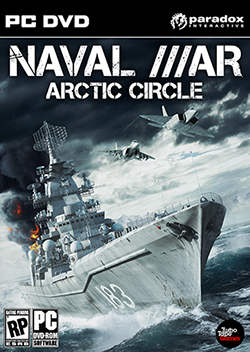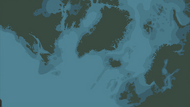Naval War
Topic: Software
 From HandWiki - Reading time: 4 min
From HandWiki - Reading time: 4 min
| Naval War: Arctic Circle | |
|---|---|
 North American cover art | |
| Developer(s) | Turbo Tape Games |
| Publisher(s) | Paradox Interactive |
| Director(s) | Jan Haugland |
| Producer(s) | Fredrik Sundt Breien |
| Programmer(s) | Andreas Johansen, Tor-Inge Jenssen, Espen Sæverud |
| Artist(s) | Øyvind Lien |
| Composer(s) | Harald Nævdal |
| Engine | Unity |
| Platform(s) | Microsoft Windows |
| Release |
|
| Genre(s) | Real-time naval strategy |
| Mode(s) | Single-player, multiplayer |
Naval War: Arctic Circle is a real time naval strategy game developed by Norwegian development company Turbo Tape Games and published by Swedish video game publisher Paradox Interactive. It was released on April 10, 2012.[2] Naval War: Arctic Circle was announced at the 2011 Paradox Interactive Convention held in New York. The game is supported by the Norwegian Film Institute, Innovation Norway and the Norwegian Research Council, and is developed in close consultation with the Royal Norwegian Navy.[3]
As of January 23, 2013, support for the game has been discontinued by Paradox and Turbo Tape Games,[4] therefore in October 2013 the backend source code was released to the game community to allow self-support.[5]
Plot
Naval War: Arctic Circle takes place in 2030,[6] throughout the North Atlantic, Arctic Ocean and the Baltic Sea. The game revolves around an imagined conflict in the Arctic Circle, where melting ice caps have opened up the region to exploitation for its raw materials.[6] There are two differing single-player campaigns, narrated and played from Russia n and NATO perspectives, and a 4-part tutorial.[8] Additionally, one-on-one multiplayer gaming is possible through Steam services.
Gameplay
The game environment consists of a 35 mil km2 map, and features dynamic weather and a day/night cycle, which can affect certain game mechanics. The game is played in real-time, and no 'pause' functionality is available. Time compression is possible up to 120x.[9]
The game interface contains two viewports, one large and one small, which host a 2D strategic view of the playable map, and a 3D view to observe controllable units. The player can switch between the two views in the main display, and the other is shown in the smaller viewport.[9]
Serving or near-future serving real life sensors, armaments and ordnance are also included. Units and equipment in the game have properties and statistics reflect their real life counterparts as far as research by the development team allows.
There are also civilian tankers, merchant vessels, fishing boats and passenger aircraft present in the game.
Development
Turbo Tape Games have released a short series of textual and video 'developer diaries'.[10][11]
The development philosophy of the game, according to Turbo Tape Games, is that where there is potentially "a conflict between realism and gameplay, gameplay will win every time", which means that aspects of the game do not always reflect real life, albeit uncommonly. For example, "you can launch aircraft at maximum take-off weight with tailwind."[7]
End-of-support and source code release
As of January 23, 2013, support for the game has been abandoned by Paradox and Turbo Tape Games, who released a statement saying: "Naval War: Arctic Circle has reached the end of its development, and patches or DLC for the title will no longer be produced under the Paradox Interactive brand."[4] On October 16, 2013, the backend part of the game's source code was released to the game community under restrictive license terms.[5]
Reception
Before release, Paradox Interactive gave out beta copies of NWAC to journalists for review purposes. The game has frequently been likened to previous naval strategy games such as Harpoon,[12] Red Storm Rising,[13] Dangerous Waters [14] and Fleet Command.[15] The graphics have been commented on as generally lower quality than expected.[12]
See also
- Harpoon series
- Command
References
- ↑ "Naval War: Arctic Circle". GamersGate. http://www.gamersgate.co.uk/DD-NWAC/naval-war-arctic-circle. Retrieved December 9, 2012.
- ↑ "Naval War: Arctic Circle". http://www.paradoxplaza.com/games/naval-war-arctic-circle. Retrieved December 9, 2012.
- ↑ "Turbo Tape Games AS". LinkedIn. http://www.linkedin.com/company/turbo-tape-games-as. Retrieved December 9, 2012.
- ↑ 4.0 4.1 "The state of Naval War: Arctic Circle, no longer supported - SUBSIM Radio Room Forums". http://www.subsim.com/radioroom/showthread.php?t=201645.
- ↑ 5.0 5.1 Naval War Arctic Circle Source Code! in 'Naval War: Arctic Circle' by BjornB (Oct 16, 2013)
- ↑ 6.0 6.1 6.2 Koh, Gavin (March 25, 2012). "Daily PC Game Reviews: Preview - Naval War: Arctic Circle". Daily PC Game Reviews. Archived from the original on January 21, 2013. https://archive.today/20130121062720/http://www.dailypcgamereviews.com/2012/03/preview-naval-war-arctic-circle.html. Retrieved December 9, 2012.
- ↑ 7.0 7.1 "Naval War: Arctic Circle - Developer Diary #1". 24 February 2011. http://forum.paradoxplaza.com/forum/showthread.php?523254-Naval-War-Arctic-Circle-%96-Developer-Diary-1. Retrieved December 9, 2012.
- ↑ "Naval War: Arctic Circle - PC". IGN. http://uk.pc.ign.com/objects/100/100744.html. Retrieved December 9, 2012.
- ↑ 9.0 9.1 Pinsof, Allistair (December 7, 2012). "Preview: Naval War: Arctic Circle". Destructoid. http://www.destructoid.com/preview-naval-war-arctic-circle-209421.phtml. Retrieved December 9, 2012.
- ↑ Video dev diary #1, Video dev diary #2
- ↑ "Naval War: Arctic Circle - Developer Diaries Collection". 10 October 2011. http://forum.paradoxplaza.com/forum/showthread.php?564135-Naval-War-Arctic-Circle-%96-Developer-Diaries-Collection. Retrieved December 9, 2012.
- ↑ 12.0 12.1 Waters, Josh (June 2012). "Navl War Arctic Circle Review". Impulse Gamer. http://www.impulsegamer.com/pcnavalwararcticcircle.html. Retrieved December 9, 2012.
- ↑ Cobb, Jim (March 12, 2012). "PC Game Preview: Naval War: Arctic Circle". Wargamer. Archived from the original on June 27, 2012. https://web.archive.org/web/20120627025515/http://www.wargamer.com/article/3165/pc-game-preview-naval-war-arctic-circle. Retrieved December 9, 2012.
- ↑ Tortorice, Scott (March 28, 2012). "An Interview with Turbo Tape Games". GameSquad. http://www.gamesquad.com/feature/interview-turbo-tape-games. Retrieved December 9, 2012.
- ↑ GameShark.com review
External links
 |
25 views | Status: cached on July 16 2024 03:07:27
↧ Download this article as ZWI file
 KSF
KSF
